
Welcome to Revisiting Disney! This week, we are looking at one of the Disney movies that is viewed as a little controversial, Pocahontas! Like always, I have labeled each category so if you want to skip to the parts that interest you most, feel free. And, of course, if you have any thoughts, burning or otherwise, please share in the comments!
BACKGROUND OF POCAHONTAS
Released on June 23rd, 1995, Pocahontas captured the attention and imagination of young people everywhere. I was one of those children, drawn into the story, admiring the brave Princess, and singing along to the wonderful music which became a staple of show choirs throughout the ’90’s and early 2000’s.
Then, one day, I learned that it was based on a true story. At first, this didn’t bother me, but after I began to research this source material and really dive into it, I began to notice differences. Not just small ones, but major and jarring ones. This really bothered my young historian-in-training soul, and still kind of bother me when I rewatch Pocahontas today.
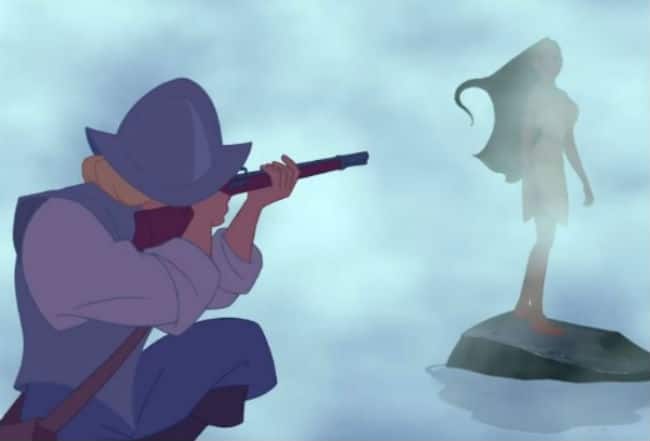
Photo: Disney
Made around the same time as The Lion King, Pocahontas was supposed to be a more prestigious film. In the “Making Of” features for The Lion King, the animators call the team who worked on Pocahontas the “A Team,” and remember how a lot of animators were jumping ship, in some ways to get off of The Lion King and onto Pocahontas. Although Pocahontas did not make as much as The Lion King and is not regarded as that film, it did make money. Regardless of that, however, and no matter how I feel about its historical accuracy (or lack thereof), the story of Pocahontas is fascinating.
The idea for a movie based on this story was pitched back in 1991 and is based on the story of Pocahontas and the early settlers at Jamestown in Virginia. We’ll come back to that in the “Source Material” section, but I did want to mention it here. The film took a bit of time to develop, mostly because of the attention to detail and the desire to make the film look as realistic as possible. Honestly, however I may feel about it personally, there is no denying that it is a gorgeous film. And it was a success; the film went on to make “over 100 million in domestic gross,” (Thomas 1992: 148).
MUSIC
Although Pocahontas was not nominated for Best Picture at either the 1996 Academy Awards or Golden Globes, it was nominated for Best Original Song-Motion Picture for “Colors of the Wind,” winning at both events, and for Best Music, Original Score, which it won at the Oscars (though not at the Golden Globes).
The team behind the music of Pocahontas was made up of Alan Menken and Stephen Schwartz, the music and lyrics, respectively. Stephen Schwartz would go on to write the lyrics for The Hunchback of Notre Dame, The Prince of Egypt, Enchanted and also several musicals. These include Pippin, Godspell, and Wicked.
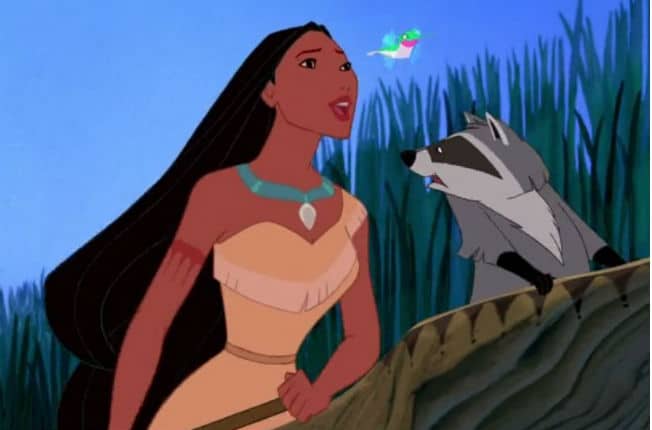
Photo: Disney
There were some lyrics changed in later releases, particularly in the song “Savages,” where the settlers and the Native Americans sing about the other group, and how they are going to war. The main message is that the two groups fighting each other don’t know about each other and that the main way to peace was through understanding and learning about other cultures.
The music is catchy and drives the plot. According to some sources, the song “Colors of the Wind” was written first, which then influenced the way the entire story was told. It’s a song that is this still fairly popular today. Both the songs and the score fit well into the established world and the soundtrack is pretty lush and grand-sounding, which complements the animation.
ANIMATION
In his book on animation, Bob Thomas called Pocahontas the Disney film that highlights natural elegance. The animators who worked on the film went to Jamestown and the Shenandoah Valley to see where the historic events had taken place so that they could best translate the landscape to film.
Thomas reports that the animators were “struck by the very strong verticals and horizontals in the region,” as well as trying to “present the world in a way that was kind of enchanted…so special, so delicate, so wonderful that it would be a shame if something happened to it” (Thomas 1992: 145). This comes across in the backgrounds, which are very realistic in many places. It’s the kind of art you can hang on your wall.
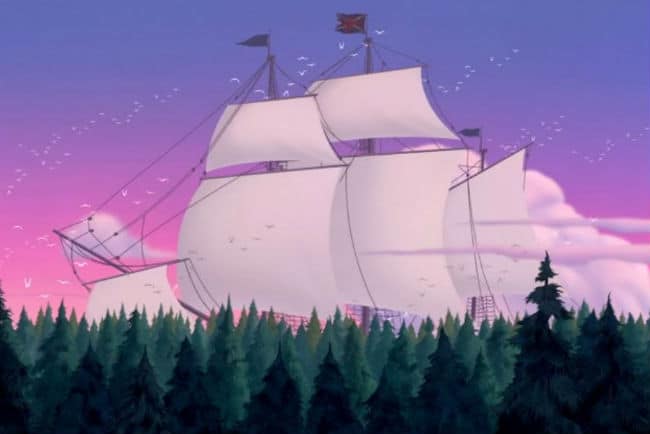
Photo: Disney
An interesting thing about Pocahontas is that the Art Director, Michael Giaimo, also used color to portray the emotion of the scene. The lack of color shows sadness while the use of bright red shows anger and violence.
Glen Keane, who had animated the Beast in Beauty and the Beast, animated Pocahontas, which Bob Thomas calls a “different kind of challenge,” as she had to be realistic looking (Thomas 1992: 146). Since the style of the film was more realistic, the characters had to be able to portray the emotions they are feeling.
Pocahontas, then, was a challenge to draw, not only because humans are very challenging, but also because she was often silent. Despite that, we still knew what she was thinking. The team remembers that Keane had looked at lots of photos of Native American women to try to make sure that Pocahontas did look Native American.
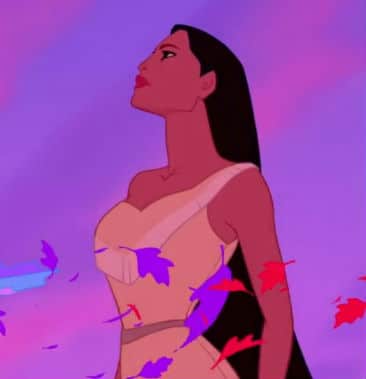
Photo: Disney
According to Thomas, the animation required a lot of draftsmanship, because the lines were so crisp and the animation is so realistic. Honestly, any complaint that I have about this movie is not related to the beautiful and very human animation, it’s related to the story (and the way it relates to the source material).
THE PLOT
The story was developed by Mike Gabriel and Joe Grant (who had worked on Dumbo), with Eric Goldberg (from Aladdin) as a co-director with Gabriel. The story starts off with a group of settlers heading to the New World with the Virginia Company, looking to make their fortunes in a land full of gold and other mineral treasures.
The crew is joined by the intrepid adventurer Captain John Smith, who is apparently an expert on traveling the world and fighting the native peoples. As the ship gets out to sea, however, she encounters a terrible storm. One of the young sailors, a lad named Thomas, calls for John to help with the cannons, which are coming loose and sliding about the deck. This is, of course, a bad thing and must be stopped.
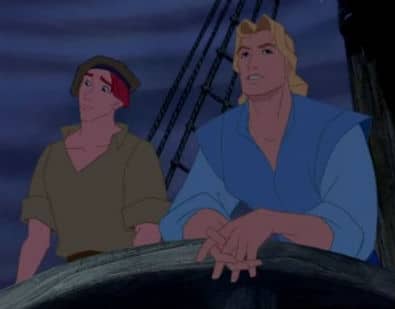
Photo: Disney
In the commotion, young Thomas is swept overboard. Looking to save his young friend, John ties a line to his body, has a sailor release the pin (so he’s attached to the ship) and dives in. Of course, the block that the line was attached to breaks (so basically, they’re in danger of no longer being attached to the ship), and the other sailors pull them ashore.
When everyone praises him for his bravery, John remarks that he knows everyone there would risk their lives to save him too. Sheepishly, the crew agrees. Disney must love animated storms and shipwrecks; they seem to pop up quite a bit! After a rousing speak from Governor Radcliffe, who apparently wants to use the men to dig up the gold for him, the men sing about what lies ahead – gold, land, and conquest.
Here, we fade out to our title, and the introduction of the Powhatan. According to special features, the Disney Studio did hire main Native American actors, as well as several consultants. They also held a meeting with a shaman. Russell Means, who provided the modeling and voice of Chief Powhatan, called the film (particularly this scene, as “the single best representation of American Indians that Hollywood has ever done,” though there have been a lot of disagreements on that point (which we’ll talk about in the Source Material section below).
Chief Powhatan and his men return from a battle fought to protect their village, and there are tons of happy reunions. Powhatan, however, notices that his daughter is not there. When he mentions it, he is told by Kekata, the shaman (I think), that Pocahontas, as her father knows, goes where the wind takes her.
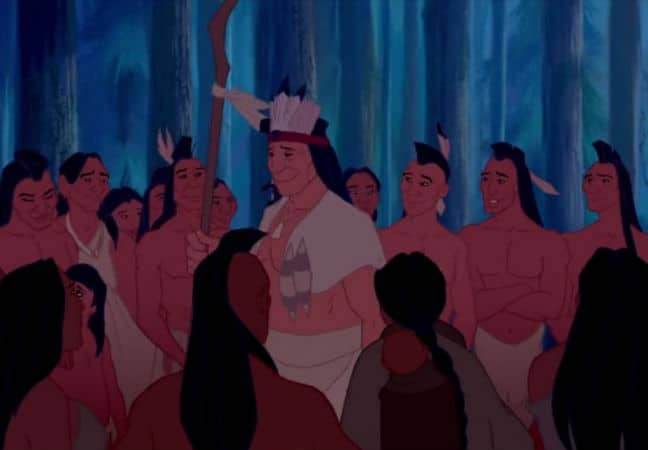
Photo: Disney
Her best friend Nakoma finds Pocahontas and tells her that her father is back. With her friends Flit the hummingbird and Meeko the raccoon, Pocahontas dives off the cliff into the water. When she doesn’t come up for a while, Nakoma is concerned. That is until Pocahontas flips over the canoe her friend is sitting in.
Eventually, the two girls make to the village in time to see Kocoum, one of the warriors, honored for his bravery in battle. Pocahontas’ father is glad to see her, and she tells him that she’s been having a dream that she thinks means that something exciting is about to happen.
Her father tells her something exciting is going to happen; Kocoum has asked for her hand in marriage and he has expected this (as fathers can do). Pocahontas is reluctant, but her father reminds her that she has a duty to her people to be steady as the river, and gives her a necklace that once belonged to her mother for her wedding.

Photo: Disney
Pocahontas, however, wonders if her dream is pointing her down another path (just around the river bend, as the song goes), and heads to get advice from Grandmother Willow. She tells her about the dream she’s been having about a spinning arrow. Grandmother Willow tells her that the dream is pointing her down her path, and she needs to listen with her heart, and she will know what it means.
She hears that something is coming, sees the sails of the ship, and runs down to the water to see the landing party, led by John Smith. They haul the ship in, and John climbs a tree near where Pocahontas is hiding. Meeko, being curious and hungry, makes friends very quickly and leads John to Pocahontas’ hiding place.
Flit drives him away, however, and as Governor Radcliffe is coming ashore, John has to go. Radcliffe, it turns out, is jealous of how much the men like John, and is also really needing this mission to be a success, because he’s been branded a failure at court. The gold will help his image.
Back at the Powhatan Village, news has reached them of these strange new visitors. After discovering that the intruders are different, with weapons that shoot fire and little regard for the rest of the world, Kocoum wants to attack right away. Powhatan points out that they don’t know anything about this new group, so he sends a small group to observe them.
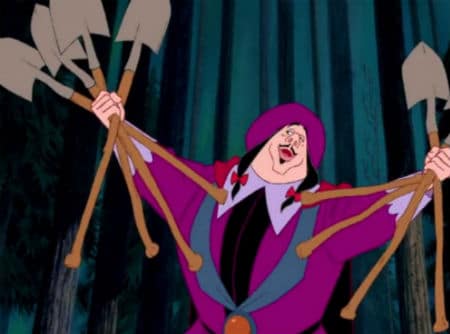
Photo: Disney
Meanwhile, Radcliffe sends John out to explore and see if he can find any Indians, while the rest of the men unload the ship, start building, or start digging for gold. He plays into their desires to be fabulously wealthy, and the men start tearing into the environment, with no care for the consequences. While they are doing this, Pocahontas follows John Smith as he wanders throughout the area, admiring the view.
Eventually, John Smith realizes he is being followed and is prepared to shoot when Pocahontas is revealed. She runs away, being afraid, but he goes after her, promising to not hurt her. She remembers to listen with her heart, and they are able to understand each other.
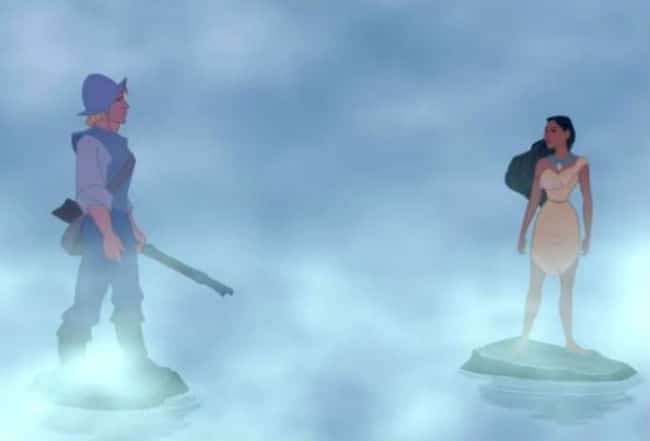
Photo: Disney
The total destruction of the land, of course, is what the Powhatan observe as they count the number of settlers. Radcliffe’s dog, Percym finds the warriors and the settlers, taught to fear the Natives, shoot. The warriors return fire, and in the fight, one of the warriors is badly injured.
Because of this, the village is now on high alert and warned away from the settlers. Plus, messages are going to be sent to the other villages that help is needed to fight this battle. The settlers are focusing on their fort now, and Radcliffe criticizes Thomas for not knowing how to shoot.
Of course, Pocahontas and John are unaware of all of this, as they are exchanging words in their respective languages. When John starts to tell her about London, she is intrigued, but when he tells her that they’re going to build those things there and tells her that they’ve improved the lives of savages all over the world, she decides to show him the things he doesn’t know, about the natural world. She points out that “savage” and “uncivilized” seem to just mean “different than him,” which leads into the iconic song, “Colors of the Wind.”
When Pocahontas hears the drums that mean trouble, she runs home. Several days pass and at the fort, John is restless. Radcliffe decides that the Powhatans must have the gold, because why else would they attack? John sneaks off to see Pocahontas, and Radcliffe sends two of the settlers to find him. At the village, Pocahontas is restless and when John appears in the field, she begs Nakoma to not say anything to Kocoum (who is coming to see her soon) and leads John away.
Kocoum and Nakoma are clearly both concerned about Pocahontas, and unsure of what to do to help her. Pocahontas brings John to Grandmother Willow, and when he asks her about gold, she lets him know that she’s never seen gold before. They’re talking to Grandmother Willow when John Smith’s friends from the fort appear in search of him.
They make plans to meet up later that night though Pocahontas feels guilty because his friends are fighting her people, who are preparing for war. When the reinforcement warriors arrive, Pocahontas finds out that her father would talk to a settler; if the option were there (he doesn’t want to fight). Her new plan, I guess, would be to bring John to her father.
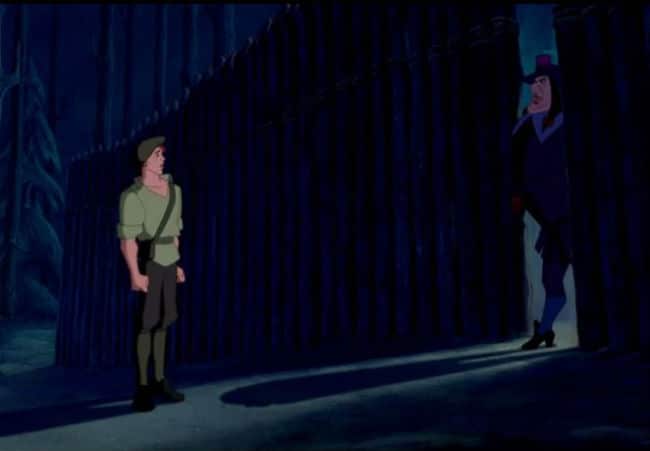
Photo: Disney
Arriving back at the fort, John shows Thomas how to shoot a gun. When Radcliffe tells him that the battle is coming soon, John tries to tell his friends that he met one of the Natives and that they can work together. Plus, he adds that there is no gold. Radcliffe refuses to believe it, however, and makes a new rule, if you see an Indian and don’t kill them, you’re a traitor and must die.
Pocahontas and John both prepare to meet by Grandmother Willow, though they are not alone. Radcliffe sends Thomas after John while Nakoma tells Kocoum that she thinks Pocahontas is in trouble, so he follows her. The two watch in horror as Pocahontas and John discuss peace and share a kiss; the kiss being more horrifying to both her fiance and his friend.

Photo: Disney
Kocoum is more enraged and charges John, prepared to kill him, despite Pocahontas’ pleas. Trying to save his friend’s life, Thomas remembers his shooting lessons and kills Kocoum. With the warriors drawing near, however, John sends Thomas back to the fort and is promptly taken prisoner.
Powhatan is angry at Pocahontas, because if she hadn’t left the village, Kocoum would still be alive. Feeling guilty because John is to die at dawn, with Nakoma’s help she is able to see him again before running to Grandmother Willow, to puzzle out how to fix things.
Realizing that John is captured, Radcliffe uses this to convince his men to prepare for battle. As the warriors and settlers march toward each other, Pocahontas realizes that the spinning arrow from her dream was a compass, and realizes that her path leads her to John and to a fight for peace.
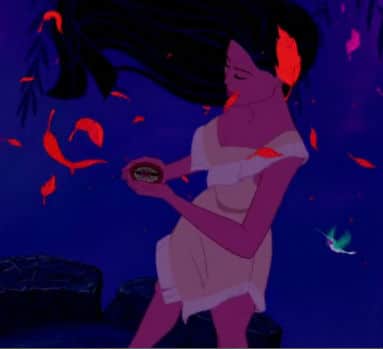
Photo: Disney
She reaches her father just in time to save John and convinces her father to let him go because the path of hatred has gotten them nowhere good. The settlers lower their guns as well. Suddenly Radcliffe, blinded by hatred and greed, aims at Powhatan. John steps in front of the bullet and is shot. The enraged settlers tie up their former governor and send him back to England.
Sadly, John has to go back too, to be treated for his gun wound. He and Pocahontas say goodbye, but because they were willing to fight for their love, relations between the Powhatan and settlers are peaceful. Until the sequel, that is.
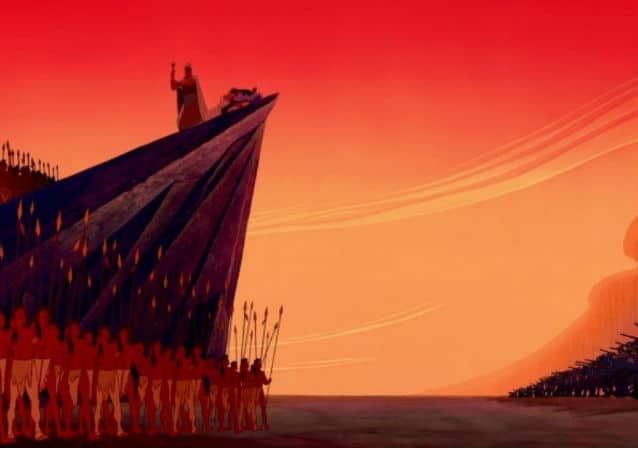
Photo: Disney
SOURCE MATERIAL
The thing that always bothers me about the film is the historical inaccuracy. I know it’s an animated film, but when you tell me that a film is based on a true story and tightly tied to history, I tend to expect a lot of it.
Pocahontas is based on the life of a real woman who was the daughter of the paramount chief of the Powhatan Chiefdom. According to the research done by the National Park Service at Jamestown, she was born in about 1596 and named Amonute, Pocahontas being her nickname (it means “playful one”).
The settlers arrived in Jamestown in May of 1607, and soon after, Captain John Smith was captured by Pocahontas’ uncle and brought to the capital of the Powhatan Chiefdom. There, according to John Smith, he was brought to Chief Powhatan and placed with his head on two large stones. Then, a warrior raised his club to smash Smith’s brains in; before this could happen, however, Pocahontas rushed in and laid her head on his, which stopped the execution.
This part of the story of Pocahontas is drawn mostly from the recollections of Captain John Smith, who wrote his account 17 years after the events that occurred, and while the story is captivating, it does make you wonder how accurate it is.
Of course, there are theories that this was part of an adoption ceremony, and that Smith was never actually in danger, which would make sense. However, Chief Roy Crazy Horse of the Powhatan Renape Nation points out that John Smith never actually wrote about Pocahontas until after her death, when she was famous in both the colonies and in London.
Chief Roy Crazy Horse points out that out the Powhatan Nation complained to Disney about the film, saying that it “distorts history beyond recognition,” and he then outlines the life of Pocahontas in a very clear and concise manner. He points out that she had actually been a young girl when John Smith was in Jamestown, not a young woman like she was in the film.
Pocahontas also had a much more tragic life in history. She was seen as an important member of her tribe, as her father’s favorite daughter, often sent out as part of negotiations between her people and the settlers. However, as relationships between the two groups got worse with the settlers demanding more and more food, Pocahontas would be kidnapped by the settlers to force her father to negotiate. She had been in Jamestown on a social call, and then treacherously captured.
While in captivity, Pocahontas married an English widower, John Rolfe (her earlier marriage to Kocoum, a man back home, ended then). Her father agreed to the match, and in 1614, Pocahontas converted to Christianity. She changed her name to Rebecca, and their marriage brought about a peace in the region.
Traveling to England in 1616, Pocahontas and her family traveled to England to represent the colony, taking with them about a dozen Powhatan men and women with them. The family would move to the country, where Pocahontas would cross paths with John Smith again though according to accounts it was not a friendly meeting.
Pocahontas would die in March 1617 when the family was heading back to Virginia. Historians aren’t sure if she died of dysentery or of pneumonia, but it was sad regardless. She never saw her home again, though her descendants are still living today.
The story of Pocahontas is one that is not one that is typically associated with Disney films. To try to balance the tragedy and gravity of the historical situation, Disney used less comedy than they typically do, so “the ratio of comedy to drama was set at 1:3, a reversal of the usual Disney formula,” (Thomas 1992: 148). Despite the attempt to seriously honor a fascinating woman, Disney’s Pocahontas turned a tragic tale into an early American Romeo and Juliet, offending many people.
The 1990’s
1995 was the year of the OJ Simpson Trial, the Oklahoma City Bombing, the beginning of sanctions against Iran, the execution of writer/activist Ken Saro-Wiwa in Nigeria, and an earthquake in Japan that killed almost 6,500 people.
It was also the time Syria and Israel sat down for peace talks, that the United Nations intervened in the Bosnian Civil War to negotiate a cease-fire (a treaty would be signed), and that the United States Space Shuttle (Atlantis) docked with the Russian Space Station (Mir). There were more negative things reported in 1995 than good ones, of course (some of which I didn’t mention), but there were good things.
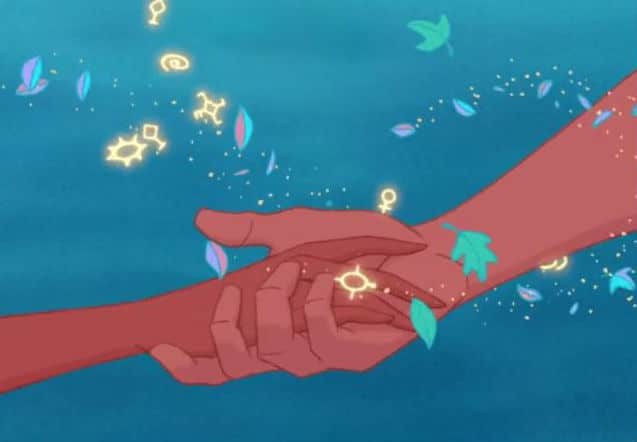
Photo: Disney
I wonder if that was part of the reason that Pocahontas didn’t do as well as expected; maybe it was too real, in some ways. The ending is less happy than you are looking for in an escapist film and it deals with some really tough issues.
I think that’s why some people like Pocahontas so much too, it may be Disneyfied history, but it is a story based on our own history. In a time when so many negative things are happening, it is always comforting to look to giants of our past, people who we can look to for inspiration. There is also a major focus on the importance of peace, and that, I think, was a major part of what also draws people in; in the chaos and bloodshed, peace can be achieved.
LESSONS LEARNED
The biggest lesson from Pocahontas, I think, is that we cannot judge people without getting to know them. The settlers and the Powhatan people did not understand each other, and the misunderstanding leads to conflict and fighting. We need to strive to understand people and work through conflict. Peace is ideal, and we should fight for it in all the ways we can.
Another major lesson is that we need to take care of the environment. It’s beautiful, and it’s what we have. We have a duty to keep it safe, and there are ways to live that don’t require the destruction of the planet.
Finally, greed is bad. That sounds like a simplistic way to phrase it, but greed sent Radcliffe to the New World and almost started a war. I mean, the film sugarcoats the historical ending, but the basic moral still stands. Greed blinds you to everything else, so don’t let it consume you.
DOES IT HOLD UP?
Honestly, Pocahontas is still not one of my favorite Disney movies. I enjoy the music and the message of peace, and it is a gorgeous film, but I cannot get over the things that bother me. The original story could have been a fascinating film, and I wish that they stuck closer to that tale. Some people love it, some people hate it. For sheer artistry alone, I’d check it out. You might really like it.
For next week: The Hunchback of Notre Dame
If you enjoyed this post and the others in the Revisiting Disney series, and have found yourself wishing that you could find them all in one convenient and bound book with eight extra essays, there is an option for you! Check out A Journey Through Disney: My Look Back Through Disney Canon, now available on Amazon as both a Kindle book ($4.99) and a paperback ($11.99).
OTHER SOURCES:
https://thewaltdisneycompany.com/about-disney/disney-history
http://www.nps.gov/jame/learn/historyculture/pocahontas-her-life-and-legend.htm
http://www.powhatan.org/pocc.html
http://studioservices.go.com/disneystudios/history.html
http://www.thepeoplehistory.com/1995.html
http://www.kidzworld.com/article/4255-1990s-timeline
Bailey, Adrian. Walt Disney’s World of Fantasy. Everest House Publishers. New York, New York. 1982.
Finch, Christopher. The Art of Walt Disney: From Mickey Mouse to the Magic Kingdom. Harry N. Abrams, Inc. New York, New York. 1975.
Johnston, Ollie and Frank Thomas. The Disney Villain. Hyperion. New York, New York. 1993.
Sale, Roger. Fairy Tales and After: From Snow White to E.B. White. Harvard University Press. Cambridge, MA, 1978.
Tatar, Maria. The Annotated Classic Fairy Tales. W.W. Norton and Company. New York and London, 2002.
Thomas, Bob. Disney’s Art of Animation From Mickey Mouse to Hercules. Hyperion. New York, New York. 1992.
Wright, Gordon. The Ordeal of Total War: 1939-1945. Harper Torchbooks, Harper & Row. New York, Hagerstown, San Francisco, and London, 1968.
ARE YOU A ROMANCE FAN? FOLLOW THE SILVER PETTICOAT REVIEW:
 Our romance-themed entertainment site is on a mission to help you find the best period dramas, romance movies, TV shows, and books. Other topics include Jane Austen, Classic Hollywood, TV Couples, Fairy Tales, Romantic Living, Romanticism, and more. We’re damsels not in distress fighting for the all-new optimistic Romantic Revolution. Join us and subscribe. For more information, see our About, Old-Fashioned Romance 101, Modern Romanticism 101, and Romantic Living 101.
Our romance-themed entertainment site is on a mission to help you find the best period dramas, romance movies, TV shows, and books. Other topics include Jane Austen, Classic Hollywood, TV Couples, Fairy Tales, Romantic Living, Romanticism, and more. We’re damsels not in distress fighting for the all-new optimistic Romantic Revolution. Join us and subscribe. For more information, see our About, Old-Fashioned Romance 101, Modern Romanticism 101, and Romantic Living 101.
